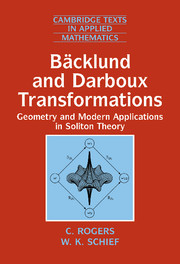Book contents
- Frontmatter
- Contents
- Preface
- Acknowledgements
- General Introduction and Outline
- 1 Pseudospherical Surfaces and the Classical Bäcklund Transformation. The Bianchi System
- 2 The Motion of Curves and Surfaces. Soliton Connections
- 3 Tzitzeica Surfaces. Conjugate Nets and the Toda Lattice Scheme
- 4 Hasimoto Surfaces and the Nonlinear Schrödinger Equation. Geometry and Associated Soliton Equations
- 5 Isothermic Surfaces. The Calapso and Zoomeron Equations
- 6 General Aspects of Soliton Surfaces. Role of Gauge and Reciprocal Transformations
- 7 Bäcklund Transformation and Darboux Matrix Connections
- 8 Bianchi and Ernst Systems. Bäcklund Transformations and Permutability Theorems
- 9 Projective-Minimal and Isothermal-Asymptotic Surfaces
- Appendix A The su(2)–so(3) Isomorphism
- Appendix B CC-Ideals
- Appendix C Biographies
- Bibliography and Author Index
- Subject Index
7 - Bäcklund Transformation and Darboux Matrix Connections
Published online by Cambridge University Press: 04 March 2010
- Frontmatter
- Contents
- Preface
- Acknowledgements
- General Introduction and Outline
- 1 Pseudospherical Surfaces and the Classical Bäcklund Transformation. The Bianchi System
- 2 The Motion of Curves and Surfaces. Soliton Connections
- 3 Tzitzeica Surfaces. Conjugate Nets and the Toda Lattice Scheme
- 4 Hasimoto Surfaces and the Nonlinear Schrödinger Equation. Geometry and Associated Soliton Equations
- 5 Isothermic Surfaces. The Calapso and Zoomeron Equations
- 6 General Aspects of Soliton Surfaces. Role of Gauge and Reciprocal Transformations
- 7 Bäcklund Transformation and Darboux Matrix Connections
- 8 Bianchi and Ernst Systems. Bäcklund Transformations and Permutability Theorems
- 9 Projective-Minimal and Isothermal-Asymptotic Surfaces
- Appendix A The su(2)–so(3) Isomorphism
- Appendix B CC-Ideals
- Appendix C Biographies
- Bibliography and Author Index
- Subject Index
Summary
In 1882, Darboux introduced his celebrated invariance of what has come to be called the one-dimensional Schrödinger equation. This result, which is but a special case of the Moutard transformation obtained in 1878, allows new solutions of the linear Schrödinger equation to be generated via solutions corresponding to a seed potential.
The spectral properties of the classical Darboux transformation were investigated much later in 1955 by the Oxford mathematician Crum. Twenty years on, Wadati et al., in pioneering work, showed that not only Bäcklund transformations but also conservation laws could be generated for canonical 1+1-dimensional soliton equations by what they termed the Crum transformation. The role of the classical Darboux transformation in soliton theory is detailed in an appendix to the monograph on the spectral transform by Calogero and Degasperis.
The Darboux matrix formalism was introduced in connection with the dressing method as originated by Zakharov and Shabat in and described in the text. Important work on the Darboux matrix method was conducted, on the one hand, by Matveev and Salle (detailed in the monograph) and, on the other hand, by Neugebauer and Meinel. Links between Bäcklund transformations and the dressing method, as well as between the latter and the classical Darboux transformation, have been elucidated by Levi et al. Therein, the Darboux matrix method plays a key role.
Information
- Type
- Chapter
- Information
- Bäcklund and Darboux TransformationsGeometry and Modern Applications in Soliton Theory, pp. 266 - 296Publisher: Cambridge University PressPrint publication year: 2002
